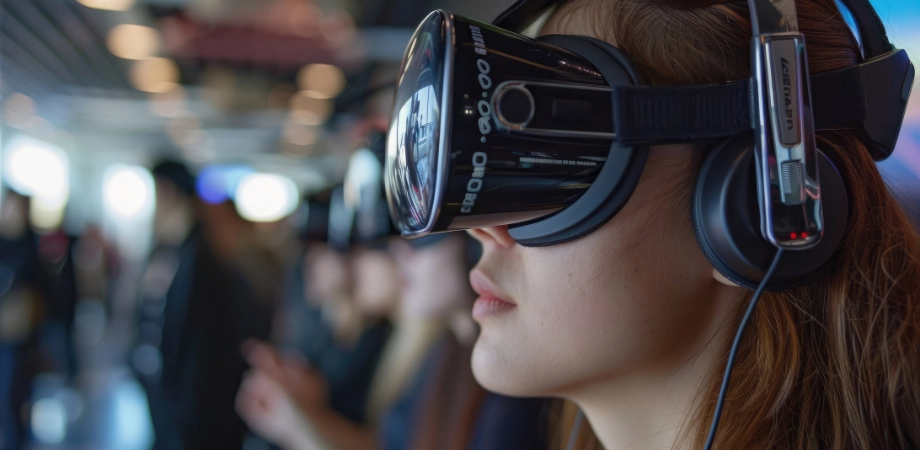Immersive gaming is transforming the way players interact with virtual environments, elevating engagement and realism to unparalleled heights. This article explores the pivotal role immersive gaming experience and game localization services play in enhancing the overall gaming experience. Whether you are a seasoned gamer or a newcomer to the world of gaming, understanding the advantages of immersive experiences and localized content is essential for recognizing the craftsmanship involved in creating these captivating worlds.
Defining the Immersive Gaming Experience
To truly understand and appreciate the immersive gaming experience, it’s important to unpack what exactly makes a game immersive and explore the psychology behind this phenomenon. The immersive gaming experience goes beyond just playing a game; it transports players into a virtual world where they become fully engaged and emotionally connected to the gameplay.
What Makes a Game Immersive?

Several key factors contribute to creating an immersive gaming experience. One of the primary elements is realistic graphics. The visual aesthetics of a game play a crucial role in transporting players into a virtual world that feels believable and visually engaging. From breathtaking landscapes to detailed character models, realistic graphics can enhance the immersion and make players feel like they are a part of the game.
Engaging gameplay mechanics also play a significant role in immersion. Games that offer a sense of agency and challenge, with responsive controls and mechanics, keep players fully engaged in the gameplay. Whether it’s solving complex puzzles, mastering combat techniques, or making impactful decisions in a branching narrative, gameplay mechanics contribute to the overall immersive experience.
Another important aspect of an immersive game is a compelling storyline. A well-crafted narrative can captivate players, draw them into the game world, and make them emotionally invested in the characters and their journeys. The storytelling elements, including dialogues, cutscenes, and character development, contribute to the overall immersion and evoke a sense of empathy and connection with the game’s world.
Psychology Behind Immersion in Gaming
Understanding the psychology behind immersion in gaming helps shed light on why the immersive gaming experience is so captivating for players. One key concept is the idea of presence, which refers to the feeling of being physically present in the virtual environment. When players feel a strong sense of presence, they are more likely to become fully immersed in the game.
Flow state, a psychological concept related to immersion, occurs when players are completely absorbed in the gameplay, losing track of time and feeling a deep sense of enjoyment and concentration. Achieving flow state is often associated with immersive gaming experiences that strike the right balance between challenge and skill, leading to a state of effortless focus and engagement.
The suspension of disbelief is also a critical factor in creating immersion. When players are able to temporarily set aside their knowledge that they are playing a game and fully accept the rules and realities of the game world, they are more likely to feel immersed in the experience. This suspension of disbelief allows players to emotionally invest in the game and connect with its world on a deeper level.
Components of an Immersive Digital Environment

An immersive digital environment consists of various components that work together to create a truly immersive gaming experience. One of the primary components is audio, including background music, sound effects, and voice acting. Immersive sound design enhances the atmosphere, immerses players in the game world, and adds depth and realism to the overall experience.
Visuals are another crucial component. Realistic graphics, detailed environments, and lifelike character models transport players into visually stunning virtual worlds. The combination of aesthetically pleasing visuals and attention to detail further enhances the immersion and makes players feel fully immersed in the game.
The user interface (UI) design also plays a role in creating an immersive digital environment. A well-designed UI that seamlessly integrates with the gameplay and provides intuitive navigation enhances the player’s immersion by creating a smooth and immersive user experience.
Interactive elements, such as in-game physics, dynamic environments, and responsive AI, contribute to the interactivity of the game world and enhance the immersive experience. These elements allow players to feel like they have a real impact on the game world, creating a sense of agency and presence.
Exploring the Latest Technological Advances in Gaming
Recent technological advancements have significantly enhanced immersive gaming experiences. Consoles like the PlayStation 5 and Xbox Series X deliver advanced graphics and smooth gameplay, while high-speed internet and 5G technology enable seamless online interactions. Virtual reality (VR) and augmented reality (AR) technologies further deepen immersion, allowing players to explore virtual environments or integrate digital elements into the real world. These innovations are transforming gameplay and expanding possibilities for more engaging and realistic experiences.
The Role of Virtual Reality in Immersive Gameplay
Virtual reality (VR) has revolutionized the immersive gaming experience, allowing players to dive into virtual worlds with unprecedented realism. By donning a VR headset, players are transported into fully immersive digital environments where advancements in VR hardware and software enhance the realism of gameplay. The integration of motion tracking translates physical movements into the virtual space, further deepening the player’s sense of presence and immersion in the game.
Moreover, VR technology enhances the immersive gaming experience through haptic feedback and lifelike graphics. Haptic feedback delivers tactile sensations that mirror in-game actions, adding a layer of realism, while state-of-the-art graphical improvements provide stunning visual fidelity. These elements combine to create a compelling and realistic environment, making players feel truly embedded within the virtual world, pushing the boundaries of what gaming can offer.
Augmented Reality: Blending Physical and Digital Worlds
Augmented reality (AR) has transformed the gaming industry by seamlessly merging the physical and digital realms, creating immersive gaming experiences that blend reality and fantasy. AR technology allows players to interact with virtual elements overlaid onto their real-world environment, enhancing the immersion and introducing novel gaming possibilities. A prime example of this is Pokémon Go, where players hunt for virtual creatures in real locations, using their smartphones to bridge the gap between the virtual and the real. This innovation in AR gaming has shown the potential for engaging millions globally by incorporating the everyday environment into the gaming experience.
Furthermore, AR extends beyond mobile gaming to tabletop and head-mounted displays, offering diverse ways to enhance the immersive gaming experience. For instance, tabletop games augmented with AR can project dynamic, virtual environments right on a physical table, bringing characters and landscapes to life. Companies like Magic Leap and Microsoft are advancing AR headsets, pushing the boundaries of how players engage with virtual worlds by offering deeper integration of digital elements with the physical world. As AR technology advances, its role in gaming is set to expand, continually pushing the envelope of what interactive gaming can be.
Sound Design: Creating an Audio Narrative for Enhanced Immersion
Sound design is a vital component of creating an immersive gaming experience, enriching the overall atmosphere and narrative through background music, sound effects, and voice acting. By shaping the emotional landscape, sound design influences mood, builds suspense, and enhances the sense of presence within the virtual world. Audio elements in immersive games not only complement visual cues but also fill gaps, adding depth and directing players’ focus. For example, haunting melodies in a post-apocalyptic wasteland or escalating sounds during a monster chase amplify the game’s intensity. Effective audio narratives strengthen the connection between players and the game’s world, with memorable voice acting and realistic sound effects making virtual environments feel more tangible and engaging. Through meticulous sound design, developers can transport players into captivating, emotionally engaging worlds, significantly elevating the immersive gaming experience.
Engaging Storytelling and Character Development
In the realm of immersive gaming, engaging storytelling and compelling character development are crucial for creating deeply memorable experiences. A well-crafted narrative can transport players into a rich and immersive world, making them emotionally invested in the unfolding story, whether it’s through epic adventures or complex thematic explorations. Character development enhances this immersion, with distinct personalities and arcs that evoke empathy and connect players to the virtual world. As players make choices and build relationships with these characters, their sense of agency and involvement deepens. Games like “The Last of Us” and “The Witcher 3: Wild Hunt” demonstrate how sophisticated storytelling and rich character development can significantly elevate the immersive gaming experience, drawing players into a vividly alive world and maintaining their engagement through emotional investment and interactive narratives.
Advanced Graphics: Pushing the Boundaries of Realism
In the world of gaming, advanced graphics are essential for creating visually captivating and immersive gaming experiences. Photorealistic visuals, achieved through detailed textures, realistic lighting, and advanced rendering techniques, allow games to emulate real-world environments with striking accuracy, enhancing the immersion and emotional impact for players. These advancements in graphics technology not only transport players to fantastical realms but also deepen their emotional connection to the narrative as they explore breathtaking landscapes and interact with lifelike characters. Innovations like ray tracing and dynamic lighting continue to push the boundaries of realism, offering more immersive environments and interactions. As game developers leverage these technologies, players can anticipate increasingly sophisticated and visually stunning experiences that enhance the overall immersive gaming experience.
The Psychological Impact of Immersive Gaming

Immersive gaming experiences significantly impact players psychologically, stimulating and engaging their minds, which leads to various cognitive benefits. Engaging with complex challenges within games improves problem-solving skills, enhances mental agility, and sharpens decision-making abilities. Additionally, the creative aspects of gaming, such as character customization and in-game design, encourage players to think innovatively, potentially boosting creativity in real-life scenarios. This immersive gaming experience also offers escapism and stress relief, providing a mental break from real-world pressures and contributing positively to mental well-being.
Furthermore, the therapeutic potential of immersive gaming is being explored in fields like mental health and rehabilitation. Virtual reality (VR) gaming, for instance, is being used to assist individuals with anxiety disorders, phobias, and PTSD through safe exposure therapy environments. In rehabilitation, immersive gaming helps in the recovery of motor skills and coordination post-injuries or strokes by creating engaging and interactive gameplay experiences that motivate and facilitate both physical and cognitive rehabilitation. These therapeutic aspects highlight the profound and diverse impacts that immersive gaming experiences can have on psychological health and recovery.
Community and Multiplayer: Enhancing Immersion Through Social Interaction
In immersive gaming, social interaction through cooperative gameplay profoundly enhances the overall experience by promoting teamwork and camaraderie. Players collaborate towards common goals, leveraging their unique abilities, which not only deepens the immersion but also fosters a shared sense of achievement and connection. These immersive multiplayer environments encourage effective communication and teamwork, allowing players to form meaningful bonds within the virtual world.
Competitive gameplay adds another dimension to the immersive gaming experience, intensifying the thrill through multiplayer battles and eSports. This mode tests individual skills while promoting intense social interactions, with the competitive spirit and adrenaline rush heightening the sense of immersion. Additionally, online communities dedicated to gaming play a crucial role by providing spaces for players to connect, share strategies, and enhance their sense of belonging, further enriching the immersive gaming experience and fostering a supportive network among gamers.




